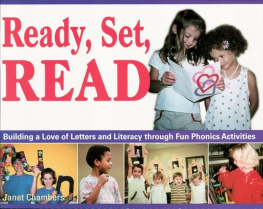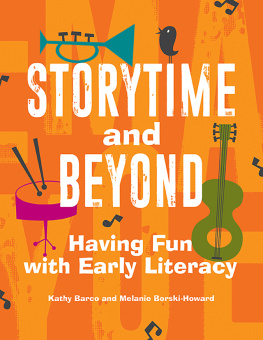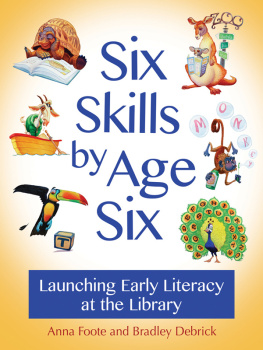Contents
Chapter 1
Linking Environmental Print With Literacy Skills
Chapter 2
Linking Environmental Print With Books and Stories
Chapter 3
Linking Environmental Print With Building, Blocks, and Bulletin Boards
Chapter 4
Linking Environmental Print With Group Time, Movement, and Music
Chapter 5
Linking Environmental Print With Math
Chapter 6
Linking Environmental Print With Science
Chapter 7
Linking Environmental Print With Small Motor Skills and Creativity
Chapter 8
Linking Environmental Print With Dramatic Play
Chapter 9
Connecting Home and School With Environmental Print
Chapter 10
Linking Environmental Print With My Community
Everyday Literacy
Environmental Print Activities for Children 3 to 8
Stephanie Mueller
Illustrated by Kathy Dobbs
Dedication
To children everywhere who grow up starting their day reading the backs of cereal boxes just like I did.
To my friend, Ann, whose encouragement set me on this path.
To all those at Friends of Early Education whose impact on the world of children will live forever.
And especially to my dear family whose support and patience make it all possible.
Illustrations: Kathy Dobbs

Gryphon House
Silver Spring, MD
Copyright
2005 Stephanie Mueller
Printed in the United States of America.
Illustrations: Kathy Dobbs
Cover Photography: Herrmann + Starke, LLC. Digital Photography, Ellicott City, MD.
Published by Gryphon House, Inc.
Gryphon House, Inc.
PO Box 10
6848 Leons Way
Lewisville, NC 27023
Telephone: 336-712-3490 1-800-638-0928 (US only)
Fax: 1-877-638-7576
Visit us on the web at www.gryphonhouse.com
All rights reserved. No part of this publication may be reproduced, stored in a retrieval system or transmitted in any form or by any means, electronic, mechanical, photocopying, recording or otherwise, without the prior written permission of the publisher.
Reprinted November 2010
Library of Congress Cataloging-in-Publication Data
Mueller, Stephanie R.
Everyday literacy: environmental print activities for children 3-8 / by Stephanie Mueller.
p. cm.
Includes bibliographical references and index.
ISBN 978-0-87659-286-1
1. Language arts (Early childhood) 2. Early childhood educationActivity programs. I. Wheeler, Ann E. II. Title.
LB1139.5.L35M84 2005
372.6dc222004020394
Bulk purchase
Gryphon House books are available for special premiums and sales promotions as well as for fund-raising use. Special editions or book excerpts also can be created to specification. For details, contact the Director of Marketing at Gryphon
House.
Disclaimer
Gryphon House, Inc. and the author cannot be held responsible for damage, mishap, or injury incurred during the use of or because of activities in this book.
Appropriate and reasonable caution and adult supervision of children involved in activities and corresponding to the age and capability of each child involved, is recommended at all times. Do not leave children unattended at any time.
Observe safety and caution at all times.
Every effort has been made to locate copyright and permission information.
Introduction
Children develop a sense of the world around them early in life. From an early age they react to the sights, sounds, tastes, and smells of their environment. A young infant may cry in response to a loud sound, become alert in response to a particular image, and calm to a familiar voice reading a story. In infants, the brain is already at work taking in and processing information. In other words, the child is learning. Early childhood professionals know this learning and development is part of a continual process that builds throughout life. Part of the learning process in any society involves literacy. It is a process that culminates in understanding the language or symbols that society uses to communicate. As ones literacy experiences and opportunities build and expand, so does the ability to decipher the symbols, making them a meaningful and useful part of the childs or adults world. Psychologist Jean Piaget points out that cognitive development moves from the concrete to the abstract. Such is the way of early literacy development, moving from the concrete, familiar print in a childs world of favorite toys, food signs, and picture books to the expanded world of reading.
Literacy development, especially in early childhood, is enhanced through experiences such as talking about the childs print world, being read to, drawing and writing, singing songs, reciting rhymes, asking questions, and interacting with others. Parents, teachers, caregivers, older siblings, and other caring adults can provide the interaction that is vital to building a literate person. The abundant tools used to develop literacy in early childhood include looking at books and being read to, doing fingerplays, singing songs, writing, painting, drawing, and being in a print-rich environment. Of these, one is readily available despite language, culture, or socio-economic statusthe print in a childs environment (community).
What Is Environmental Print?
Environmental print consists of the symbols, letters, and words encountered in the places we live, shop, travel to, learn, work, and so on. It includes traffic signs, food labels, newspapers, menus, greeting cards, and any other print that is part of everyday living. In a school it may include the signs for the bathrooms, exits, and office. To a child it may include the labels on toys and games, a calendar, favorite restaurant signs, familiar books, and a favorite cereal box he or she reads in the morning. The print in communities varies. In one community, much of the print may be in Spanish, while in another it may contain symbols and signs related to seed and farm equipment companies.
How Can Environmental Print Help in Literacy Development?
Environmental print as a tool in literacy development has the potential to be a motivating force in creating enthusiasm toward reading and using language with young children and developmentally delayed children. It can serve as a tool in language development. The benefit of using environmental print in literacy development has been shown in some studies to be directly related to the amount of guidance a caring adult provides in using it, and emphasizing the relationships it has to alphabet letters, words, and messages. It can be as simple as reading newspaper comics out loud to a toddler or engaging a preschooler in reading familiar signs while on a trip.
Adult interaction is vital to achieve the maximum benefit of using environmental print as a tool in literacy development. It involves gradually moving from using context clues (pictures, cartoon characters, colors, shapes, photos, and so on) to the printed letters and words themselves. Teachers and caregivers can enhance the application of print as a teaching tool by addressing it in a variety of contexts, settings, and uses. This involves establishing literacy connections between the print a child sees in his or her home environment and how he or she can use it to learn through interaction with caring adults. Using this readily available tool has the potential to motivate and encourage involvement from parents and caregivers who might otherwise be reluctant or intimidated by the literacy process.












